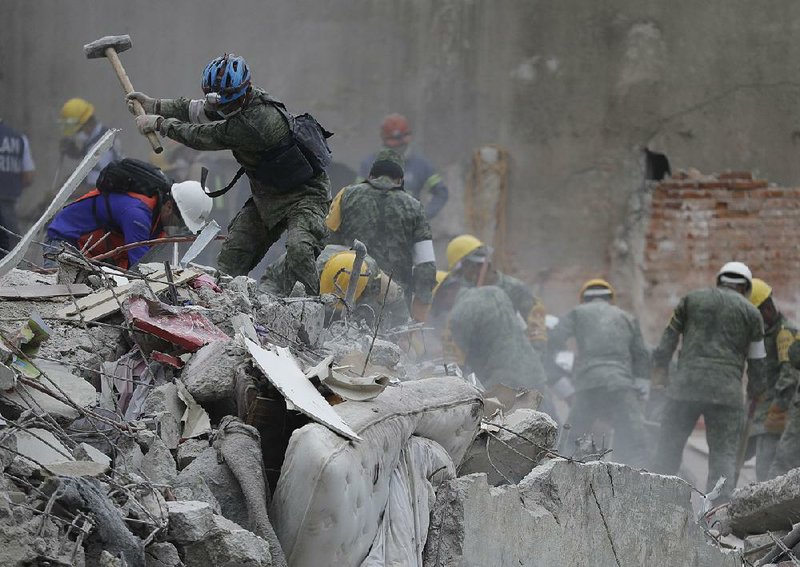MEXICO CITY -- Across Mexico City, thousands of people are believed to be homeless after this week's deadly magnitude-7.1 earthquake leveled buildings and left others teetering on the edge of collapse.
Recovery and rescue operations continue. Men, women and children are now filling up gyms and event halls at more than two dozen designated shelters. Many are uncertain where they will go next, but grateful to have a safe refuge.
On rubber mats spread across a Mexico City recreation center, the Montero family cuddles under donated wool blankets, their first new possessions having abandoned their apartment after the temblor. "I am sure nothing is going to fall here," 7-year-old Oscar Montero said.
The Montero family lived on the first floor of a seven-story apartment building that on Tuesday became perilously sandwiched between neighboring towers on each side that have begun caving in. No one in the family of five was home during the quake. Oscar and his two older siblings were all at school, his parents at work.
Click here for larger versions
Photos by The Associated Press
Photos by The Associated Press
Claudia Antonio, Oscar's mother, entered the home quickly the day after the quake to salvage her children's birth certificates and vaccination records. Other neighbors pulled out valuables such as refrigerators and microwaves. In the first night after the tremor, some slept outside with the items they had pulled from the wobbly buildings.
The Monteros decided they would go to the Junior Club recreation center.
"Material things come and go," Antonio, 38, said. "What I value most is our lives."
The Junior Club is typically a place where children can swim in the lap pool and adults spin on gym bikes. In the days since the quake it has become one of numerous makeshift "homes of refuge," receiving piles of donated bottled water, diapers and toys.
On the second floor, dozens of the newly displaced camp out on sleeping mats and share their stories. Teams of volunteers visit with each family to determine their needs.
Aside from material needs, Dr. Alfredo Reyes, who was helping out nearby at the site of a flattened six-story building, said many of the survivors are expected to struggle emotionally. A nervous fear lingers in people, sparked by any sign that buildings that once seemed unmovable might now collapse at the slightest provocation.
At one plaza where rescue workers gathered to organize supplies Tuesday night, panic spread swiftly after people shouted that they'd seen a damaged building start to sway.
"I'm scared!" a young woman cried, her voice trembling.
"They've lost loved ones, their homes," Reyes said, adding that the quake also revived old traumas from other quakes, like the one that hit Mexico City on the same day in 1985 and left thousands dead.
Oscar Montero, whose playful energy sends him bouncing through the halls of the shelter, said the initial tremor didn't scare him. He comforted the frightened children at his school.
But he is afraid to go home.
"What if there's a quake again and things break?" he asks. "Here it won't."
Meanwhile, a high-ranking navy official said Thursday that there is no missing child at a collapsed Mexico City school that had become a focus of rescue efforts, though an adult still may be alive in the rubble.
Navy Assistant Secretary Angel Enrique Sarmiento said that while there are blood traces and other signs suggesting that someone is alive, all the school's children have been accounted for.
"We have done an accounting with school officials and we are certain that all the children either died, unfortunately, are in hospitals or are safe at their homes," Sarmiento said.
The attention of many in Mexico and abroad had been drawn to the plight of a girl identified only as Frida Sofia, who was said to have been found alive under the pancaked school building and became a symbol for the hopes of thousands of rescuers working around the clock in search of quake survivors.
Multiple rescuers at the school site spoke of the girl, with some saying she had reported five more children alive in the same space. Yet no family members had emerged while rescue efforts continued, and some officials had begun to say her identity was not clear.
Tuesday's quake killed at least 274 people in central Mexico and injured more than 2,000. That included at least 21 children and five adults at the Enrique Rebsamen school in southern Mexico City.
Earlier Thursday, the navy announced that the body of a school worker had been recovered from the school.
President Enrique Pena Nieto declared three days of mourning as soldiers, police, firefighters and residents dug through the rubble, at times with their hands, gaining an inch at a time.
Information for this article was contributed by Maria Verza, Christine Armario, Christopher Sherman, Miguel Tovar, Peter Orsi and Carlos Rodriguez of The Associated Press.
A Section on 09/22/2017
